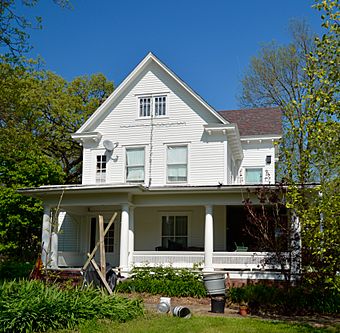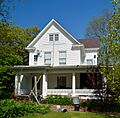James Sansom Carpenter House facts for kids
Quick facts for kids |
|
|
James Sansom Carpenter House
|
|
 |
|
| Location | 3320 Kinsey Ave. Des Moines, Iowa |
|---|---|
| Area | less than one acre |
| Built | 1890 |
| Architectural style | Colonial Revival |
| NRHP reference No. | 98000379 |
| Added to NRHP | April 23, 1998 |
The James Sansom Carpenter House was a very important place in Des Moines, Iowa, for art and culture between 1906 and 1939. This large property, called Oakwood Estate, was owned by J. S. Carpenter and his wife, Florence L. Carpenter. They named it Oakwood because of the many old oak trees growing there.
J. S. Carpenter was a big fan of art and collected many beautiful paintings and prints. His collection was so famous that art experts said it was one of the best in America! The house held 125 paintings and 350 etchings (a type of print). J. S. Carpenter was also known as "Sannie" or "Sandy" by his friends. He was a successful bridge builder.
In 1916, Carpenter started the Des Moines Association of Fine Arts. This group helped buy art for the city. Members paid money each year to help purchase paintings and sculptures. Carpenter was seen as a "Guru" (a wise leader) of fine arts in Des Moines. Many famous artists and important visitors would stay at Oakwood with the Carpenters when they came to sell their art. Carpenter led the Association until he passed away in 1939. Later, the art collection became part of what is now the Des Moines Art Center.
Contents
The Carpenter Mansion
The Carpenter house was built in 1890 and later updated in the 1920s. It is a beautiful example of Colonial Revival style, with two and a half stories. The house has six bedrooms. It features a grand front staircase made of oak wood.
The library in the house has built-in oak bookshelves and wood panels. The living room is quite large, measuring 17 feet by 33 feet. It has a lovely oak fireplace with green tiles. The ceiling in the living room has special plaster tiles, just like the historic Hoyt Sherman Place nearby. Florence Carpenter, J. S.'s wife, was involved with the Hoyt Sherman House, too. The formal dining room has walls covered in African Teak wood.
After a fire almost destroyed their art collection in 1922, the Carpenters built a special fireproof art room. This room was built with thick concrete walls, floor, and ceiling. It was separated from the rest of the house by about three feet of concrete and a strong bank vault door. This shows how much they valued their art! The house and property were recognized as a historic landmark in 1998.
Photo of Carpenter House circa 1914
The Grounds and Other Buildings
The Oakwood Estate originally covered 13 acres of land. There was a separate house for servants to the north, which is still standing today. This servant's house was sold off in the 1960s. Other parts of the land were also sold for new homes and buildings.
In 1973, a company bought the remaining five acres of the estate. They divided the land into 11 smaller lots. New houses and duplexes were built around the mansion. One empty lot next to the house was later added back to the estate in 2012.
The Carpenters and Artist Henry Ossawa Tanner
Henry Ossawa Tanner was one of the first successful African American artists in America. He was a close friend of J. S. Carpenter. It's not known exactly how they met. Their friendship likely started because Carpenter wanted to buy Tanner's paintings for the Des Moines Association of Fine Arts. Carpenter loved Tanner's art and wanted to bring as many of his works to Des Moines as possible.
Carpenter helped Tanner sell his paintings and even earned a commission (a percentage of the sale). Their friendship grew strong. Once, Carpenter found a large Tanner painting for sale in New York City. The price was much lower than it should have been. Carpenter thought the painting might have been stolen. He contacted Tanner, who was living in France, to ask about it.
Carpenter discovered that Tanner had stored some paintings with an art warehouse. The warehouse closed, and the owner took the paintings to another storage area. When the owner died, his wife sold the paintings and kept the money. Carpenter decided to find these paintings and get them back. He spent his own money to recover them. This whole process showed how much trust and friendship they shared.
Tanner also helped Carpenter buy other art, like a bronze sculpture called "Hand of Rodan." This sculpture is still part of the Des Moines Art Center's collection today. Tanner even bid on art at auctions for Carpenter and his friends. In his last years, Tanner told Carpenter he had many paintings in his studio but didn't have the strength to finish them. Their friendship lasted until their final days.
It's important to note that in the 1920s, there were reports of cross burnings by the Ku Klux Klan (KKK) near the Carpenter's estate. The KKK would ride their horses and burn crosses on a hill nearby. However, there is no information to suggest that these events were a warning to Carpenter for selling paintings by an African American artist. In fact, Carpenter continued to strongly promote Tanner's artwork.
The Carpenters and Artist Leon Kroll
Artist Leon Kroll and his wife also visited Des Moines and stayed with the Carpenters at Oakwood. J. S. Carpenter and Leon Kroll exchanged many letters. These letters are now kept at the Archives of American Art.
The Carpenters' Richard E. Miller Painting, Goldfish
The Carpenters owned a very special painting by artist Richard E. Miller called Goldfish. It was painted around 1912. The painting showed Miller's wife and daughter. Sadly, Miller's daughter passed away soon after the painting was finished. This made the painting very rare and meaningful.
The painting was later inherited by Carpenter's niece. In 1990, she offered Goldfish to the Des Moines Art Center. However, the Art Center turned down the offer. They already had another painting by Richard Miller and didn't realize how important Goldfish was because it was the artist's last painting of his daughter. Carpenter's niece then gave the painting to her old college, Simpson College. Simpson College later sold Goldfish at a famous auction house in New York in 1992.
Images for kids



